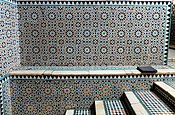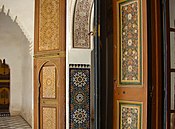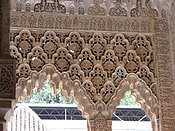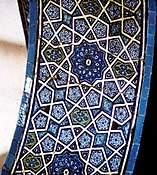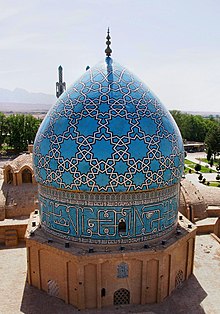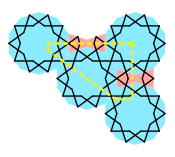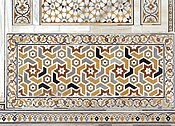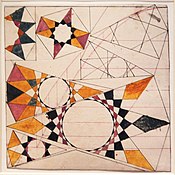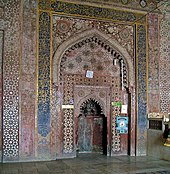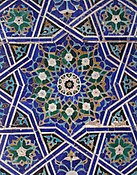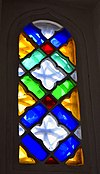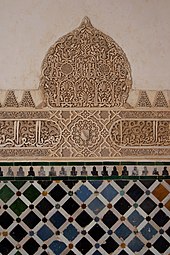
Sacred geometry ascribes symbolic and sacred meanings to certain geometric shapes and certain geometric proportions. It is associated with the belief of a divine creator of the universal geometer. The geometry used in the design and construction of religious structures such as churches, temples, mosques, religious monuments, altars, and tabernacles has sometimes been considered sacred. The concept applies also to sacred spaces such as temenoi, sacred groves, village greens, pagodas and holy wells, Mandala Gardens and the creation of religious and spiritual art.

Tiles are usually thin, square or rectangular coverings manufactured from hard-wearing material such as ceramic, stone, metal, baked clay, or even glass. They are generally fixed in place in an array to cover roofs, floors, walls, edges, or other objects such as tabletops. Alternatively, tile can sometimes refer to similar units made from lightweight materials such as perlite, wood, and mineral wool, typically used for wall and ceiling applications. In another sense, a tile is a construction tile or similar object, such as rectangular counters used in playing games. The word is derived from the French word tuile, which is, in turn, from the Latin word tegula, meaning a roof tile composed of fired clay.
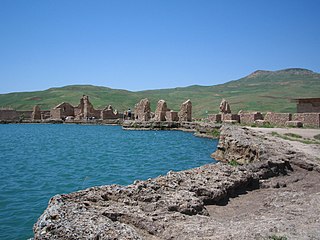
Takht-e Soleymān or Adur Gushnasp, is an archaeological site in West Azerbaijan, Iran dating back to Sasanian Empire. It lies midway between Urmia and Hamadan, very near the present-day town of Takab, and 400 km (250 mi) west of Tehran.

The Ben Youssef Madrasa is an Islamic madrasa (college) in Marrakesh, Morocco. The madrasa is named after the adjacent Ben Youssef Mosque, and was commissioned in 1564–65 CE by the Saadian sultan Abdallah al-Ghalib. Functioning today as a historical site, the Ben Youssef Madrasa was the largest Islamic college in the Maghreb at its height, and is widely recognized as a pinnacle of Saadian and Moroccan architecture.

Mudéjar art, or Mudéjar style, was a type of ornamentation and decoration used in the Iberian Christian kingdoms, primarily between the 13th and 16th centuries. It was applied to Romanesque, Gothic and Renaissance architectural styles as constructive, ornamental and decorative motifs derived from those that had been brought to or developed in Al-Andalus. These motifs and techniques were also present in the art and crafts, especially Hispano-Moresque lustreware that was once widely exported across Europe from southern and eastern Spain at the time.

Moroccan architecture reflects Morocco's diverse geography and long history, marked by successive waves of settlers through both migration and military conquest. This architectural heritage includes ancient Roman sites, historic Islamic architecture, local vernacular architecture, 20th-century French colonial architecture, and modern architecture.
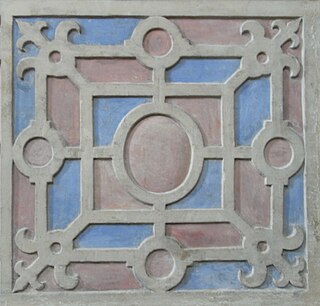
In the history of art and design, strapwork is the use of stylised representations in ornament of ribbon-like forms. These may loosely imitate leather straps, parchment or metal cut into elaborate shapes, with piercings, and often interwoven in a geometric pattern. In early examples there may or may not be three-dimensionality, either actual in curling relief ends of the elements, or just represented in two dimensions. As the style continued, these curling elements became more prominent, often turning into scrollwork, where the ends curl into spirals or scrolls. By the Baroque scrollwork was a common element in ornament, often partly submerged by other rich ornament.

A jali or jaali is the term for a perforated stone or latticed screen, usually with an ornamental pattern constructed through the use of calligraphy, geometry or natural patterns. This form of architectural decoration is common in Indo-Islamic architecture and more generally in Indian architecture. It is closely related to mashrabiya in Islamic architecture.

The Saadian Tombs are a historic royal necropolis in Marrakesh, Morocco, located on the south side of the Kasbah Mosque, inside the royal kasbah (citadel) district of the city. They date to the time of the Saadian dynasty and in particular to the reign of Ahmad al-Mansur (1578–1603), though members of Morocco's monarchy continued to be buried here for a time afterwards. The complex is regarded by many art historians as the high point of Moroccan architecture in the Saadian period due to its luxurious decoration and careful interior design. Today the site is a major tourist attraction in Marrakesh.

Moorish architecture is a style within Islamic architecture which developed in the western Islamic world, including al-Andalus and what is now Morocco, Algeria, and Tunisia. Scholarly references on Islamic architecture often refer to this architectural tradition in terms such as architecture of the Islamic West or architecture of the Western Islamic lands. The use of the term "Moorish" comes from the historical Western European designation of the Muslim inhabitants of these regions as "Moors". Some references on Islamic art and architecture consider this term to be outdated or contested.

Stucco decoration in Islamic architecture refers to carved or molded stucco and plaster. The terms "stucco" and "plaster" are used almost interchangeably in this context to denote most types of stucco or plaster decoration with slightly varying compositions. This decoration was mainly used to cover walls and surfaces and the main motifs were those predominant in Islamic art: geometric, arabesque, and calligraphic, as well as three-dimensional muqarnas. Plaster of gypsum composition was extremely important in Islamic architectural decoration as the relatively dry climate throughout much of the Islamic world made it easy to use this cheap and versatile material in a variety of spaces.
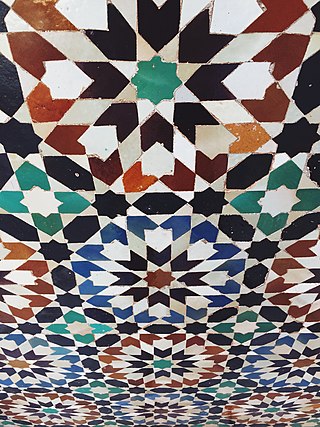
Zellij is a style of mosaic tilework made from individually hand-chiseled tile pieces. The pieces were typically of different colours and fitted together to form various patterns on the basis of tessellations, most notably elaborate Islamic geometric motifs such as radiating star patterns. This form of Islamic art is one of the main characteristics of architecture in the western Islamic world. It is found in the architecture of Morocco, the architecture of Algeria, early Islamic sites in Tunisia, and in the historic monuments of al-Andalus. From the 14th century onwards, zellij became a standard decorative element along lower walls, in fountains and pools, on minarets, and for the paving of floors.
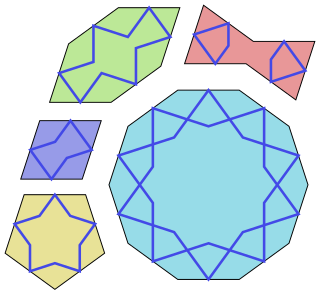
Girihtiles are a set of five tiles that were used in the creation of Islamic geometric patterns using strapwork (girih) for decoration of buildings in Islamic architecture. They have been used since about the year 1200 and their arrangements found significant improvement starting with the Darb-i Imam shrine in Isfahan in Iran built in 1453.

Girih are decorative Islamic geometric patterns used in architecture and handicraft objects, consisting of angled lines that form an interlaced strapwork pattern.

The Bou Inania Madrasa or Bu 'Inaniya Madrasa is a madrasa in Fes, Morocco, built in 1350–55 CE by Abu Inan Faris. It is the only madrasa in Morocco which also functioned as a congregational mosque. It is widely acknowledged as a high point of Marinid architecture and of historic Moroccan architecture generally.

Islamic ornament is the use of decorative forms and patterns in Islamic art and Islamic architecture. Its elements can be broadly divided into the arabesque, using curving plant-based elements, geometric patterns with straight lines or regular curves, and calligraphy, consisting of religious texts with stylized appearance, used both decoratively and to convey meaning. All three often involve elaborate interlacing in various mediums.

The Al-Attarine Madrasa or Medersa al-Attarine is a madrasa in Fes, Morocco, near the Al-Qarawiyyin Mosque. It was built by the Marinid sultan Uthman II Abu Said in 1323-5. The madrasa takes its name from the Souk al-Attarine, the spice and perfume market. It is considered one of the highest achievements of Marinid architecture due to its rich and harmonious decoration and its efficient use of limited space.

The Shah Nematollah Vali Shrine is a historical complex, located in Mahan, Iran, which contains the mausoleum of Shah Nematollah Vali, the renowned Iranian mystic and poet. Shah Nematollah Vali died in 1431 aged over 100. In 1436 a shrine was erected in his honor and became a pilgrimage site; with the attention of successive rulers contributing various additions over the centuries.

The Topkapı Scroll is a Timurid dynasty patterned scroll in the collection of the Topkapı Palace museum.

The al-Hamra Mosque or Red Mosque is a Marinid-era mosque in Fes, Morocco. It is a local Friday mosque located on the Grande Rue of Fes el-Jdid, the palace-city founded by the Marinid rulers.




